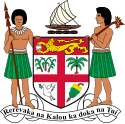Legislative Council of Fiji
This article needs additional citations for verification. (November 2015) |
 |
|---|
The Legislative Council of Fiji was the colonial precursor to the present-day Parliament, which came into existence when Fiji became independent on 10 October 1970.
The first Legislative Council
Immediately after Fiji was ceded to the United Kingdom, on 10 October 1874,
Elected European and Nominated Fijian Representation
The first step towards making the Council a popularly elected legislature was taken in 1904, when the council was reconstituted as a 19-member body consisting of the Governor, 10 official members appointed by the Governor, 6 elected members chosen by European males, and 2 Fijian members appointed by the Governor from a list of 6 nominees submitted by the Great Council of Chiefs. Persistent demands by Europeans led to an increase in their representation to seven in 1914.
First Indian Nominated member
On 20 July 1916, the composition of the Legislative Council was increased to twelve nominated members of whom eleven were official members and one a
Elected Indian Representation
On 1 May 1929, the
Racial parity of non-official members
The next major development took place in 1937, when the Legislative Council was enlarged to 32 members. Of these, 17 were official members appointed by the Governor. In addition, there were five non-official members from each of the three major ethnic groups (Fijians,
Women and Fijians enfranchised
In 1963, women were enfranchised and indigenous Fijians were empowered for the first time to vote directly for their representatives on the Legislative Council. The Legislative Council elected in 1963 had 37 members. There were 12 elected members, four from each of the Fijian, Indian and European groups chosen on a communal franchise. The Governor also nominated two from each of the communities. There were to be 19 official members. The Legislative Councillors of each race were permitted to select two from their fellows to the Executive Council. Qualifications to register as a voter disallowed illiterate adults to vote, permitted some people to choose between ethnic rolls and made no provision for Rotumans, Pacific Islanders, Chinese and Part-Chinese to vote.
Universal adult suffrage
The Legislative Council elected in 1966 had 36 members. 25 seats represented
Responsible government
After independence
When Fiji became independent on 10 October 1970, the Legislative Council was replaced by the Fijian Parliament. A grandfather clause in the Constitution provided for the old Legislative Council to remain in office, with its name changed to the House of Representatives, pending the first post-independence elections of 1972.
Changing Composition of Legislative Council
| Year of change | European Members | Fijian Members | Indian Members | Total | ||||
|---|---|---|---|---|---|---|---|---|
| Official | Nominated | Elected | Nominated | Elected | Nominated | Elected | ||
| 1875 | 6 | 4 | 0 | 0 | 0 | 0 | 0 | 10 |
| 1904 | 11 | 0 | 6 | 2 | 0 | 0 | 0 | 19 |
| 1916 | 11 | 0 | 7 | 2 | 0 | 1 | 0 | 21 |
| 1929 | 13 | 0 | 6 | 3 | 0 | 0 | 3 | 25 |
| 1937 | 17 | 2 | 3 | 0 | 5 | 2 | 3 | 32 |
| 1963 | 19 | 2 | 4 | 2 | 4 | 2 | 4 | 37 |
| 1966 | 0 | 0 | 10 | 2 | 12 | 0 | 12 | 36 |
References
- Long title: An Act for the Prevention and Punishment of Criminal Outrages upon Natives of the Islands in the Pacific Ocean), amended in 1875: Pacific Islanders Protection Acts 1875 Archived 25 September 2015 at the Wayback Machine(38 & 39 Vic. c. 51). Retrieved on 23 September 2015.
- ^ The Parliamentarian. Vol. 47. General Council of the Commonwealth Parliamentary Association. 1966.
